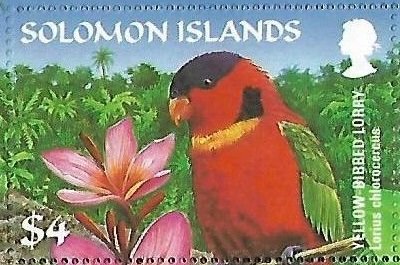Stamp: Flower and yellow-bibbed lorry (Lorius chrolocercus) (Solomon Islands 1995)
Flower and yellow-bibbed lorry (Lorius chrolocercus) (Solomon Islands 1995)
17 February (Solomon Islands ) within release Visit South Pacific Year goes into circulation Stamp Flower and yellow-bibbed lorry (Lorius chrolocercus) face value 4 Solomon Islands dollar
| Stamp Flower and yellow-bibbed lorry (Lorius chrolocercus) in catalogues | |
|---|---|
| Michel: | Mi: SB 880 |
Stamp is square format.
Also in the issue Visit South Pacific Year:
- Stamp - Hermit Crab face value 30;
- Stamp - Grapsid crab face value 1.15;
- Stamp - Scuba Diving face value 95;
- Stamp - Butterfly face value 50;
- Souvenir Sheet - Visit South Pacific Year´98 face value 4;
- Stamp - Flower and yellow-bibbed lorry (Lorius chrolocercus) face value 4;
Stamp Flower and yellow-bibbed lorry (Lorius chrolocercus) it reflects the thematic directions:
Birds (Aves), a subgroup of Reptiles, are the last living examples of Dinosaurs. They are a group of endothermic vertebrates, characterised by feathers, toothless beaked jaws, the laying of hard-shelled eggs, a high metabolic rate, a four-chambered heart, and a strong yet lightweight skeleton. Birds live worldwide and range in size from the 5 cm (2 in) bee hummingbird to the 2.75 m (9 ft) ostrich. They rank as the class of tetrapods with the most living species, at approximately ten thousand, with more than half of these being passerines, sometimes known as perching birds. Birds are the closest living relatives of crocodilians.
A flower, sometimes known as a bloom or blossom, is the reproductive structure found in plants that are floral (plants of the division Magnoliophyta, also called angiosperms). The biological function of a flower is to effect reproduction, usually by providing a mechanism for the union of sperm with eggs. Flowers may facilitate outcrossing (fusion of sperm and eggs from different individuals in a population) or allow selfing (fusion of sperm and egg from the same flower). Some flowers produce diaspores without fertilization (parthenocarpy). Flowers contain sporangia and are the site where gametophytes develop. Many flowers have evolved to be attractive to animals, so as to cause them to be vectors for the transfer of pollen. After fertilization, the ovary of the flower develops into fruit containing seeds. In addition to facilitating the reproduction of flowering plants, flowers have long been admired and used by humans to beautify their environment, and also as objects of romance, ritual, religion, medicine and as a source of food.
The Arecaceae is a family of perennial, flowering plants in the monocot order Arecales. Their growth form can be climbers, shrubs, tree-like and stemless plants, all commonly known as palms. Those having a tree-like form are called palm trees. Currently, 181 genera with around 2,600 species are known,
most of which are restricted to tropical and subtropical climates. Most palms are distinguished by their large, compound, evergreen leaves, known as fronds, arranged at the top of an unbranched stem, except for the Hyphaene genus, who has branched palms. However, palms exhibit an enormous diversity in physical characteristics and inhabit nearly every type of habitat within their range, from rainforests to deserts.
Parrots (Psittaciformes), also known as psittacines (/ˈsɪtəsaɪnz/), are birds with a strong curved beak, upright stance, and clawed feet. They are classified in four families that contain roughly 410 species in 101 genera, found mostly in tropical and subtropical regions. The four families are the Psittaculidae (Old World parrots), Psittacidae (African and New World parrots), Cacatuoidea (cockatoos), and Strigopidae (New Zealand parrots). One-third of all parrot species are threatened by extinction, with a higher aggregate extinction risk (IUCN Red List Index) than any other comparable bird group Parrots have a generally pantropical distribution with several species inhabiting temperate regions as well. The greatest diversity of parrots is in South America and Australasia




